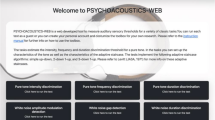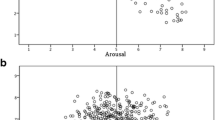Studies over the last 25 years have convincingly demonstrated that humans have several independent cutaneous mechanoreception systems. Best studied is the discriminative touch system, which combines cutaneous mechanoreceptors innervated by fast myelinated afferent type Aβ fibers and provides detailed information on the site of contact and nature of the stimulus. The affective C-tactile system was discovered relatively recently and provides unconditioned positive emotions in response to slow, gentle touching. The dynamics of the electrical response of the cortex to afferents from the C-tactile system have received almost no study, while existing data are insufficient to distinguish the components of the brain response associated with the activity of the Aβ- and C-tactile systems. This pilot study analyzed EEG event-related potentials in response to fast (30 cm/sec) and slow (5 cm/sec) stroking, applied using a robot device. A total of 13 adult subjects took part in the study. The first ERP components in the response to stroking were seen during the time interval 400–1800 msec in the lateral frontal and central leads; their amplitude was greater for fast stroking, indicating their association with activity in the Aβ system. A P2100–N2300 complex was seen only for slow stroking and was probably linked with the reaction of the Aβ system to termination of stimulation; it was accompanied by an ultra-late positive potential presumptively associated with the response of the C-tactile system. The results confirm the existent of the ultra-late positive potential identified in previous studies for slow stroking and allow this potential to be differentiated from other late components of the response.
Similar content being viewed by others
References
Abraira, V. E. and Ginty, D. D., “The sensory neurons of touch,” Neuron, 79, No. 4, 618–639 (2013).
Ackerley, R., Eriksson, E., and Wessberg, J., “Ultra-late EEG potential evoked by preferential activation of unmyelinated tactile afferents in human hairy skin,” Neurosci. Lett., 535, 62–66 (2013).
Baranek, G. T. and Foster, L. G., “Tactile defensiveness and stereotyped behaviors,” Am. J. Occup. Ther., 51, No. 2, 91–95 (2017).
Bibikov, N. G., “Encoding signal duration in the auditory system. A review,” Sens. Sistemy, 19, No. 3, 229–239 (2005).
Björnsdotter, M., Löken, L., Olausson, H., et al., “Somatotopic organization of gentle touch processing in the posterior insular cortex,” J. Neurosci., 29, No. 29, 9314–9320 (2009).
Borhani, K., Làdavas, E., Fotopoulou, A., Haggard, P., “’Lacking warmth’: Alexithymia trait is related to warm-specific thermal somatosensory processing,” Biol. Psychol., 128, 132–140 (2017).
Ehret, G. and Merzenich, M. M., “Complex sound analysis (frequency resolution, filtering and spectral integration) by single units of the inferior colliculus of the cat,” Brain Res. Rev., 472, No. 2, 139–163 (1988).
Essick, G. K., James, A., and McGlone, F. P., “Psychophysical assessment of the affective components of non-painful touch,” Neuroreport, 10, No. 10, 2083–2087 (1999).
Essick, G. K., McGlone, F., Dancer, C., et al., “Quantitative assessment of pleasant touch,” Neurosci. Biobehav. Rev., 34, No. 2, 192–203 (2010).
Feldman, R., Golan, O., Hirschler-Guttenberg, Y., et al., “Parent-child interaction and oxytocin production in pre-schoolers with autism spectrum disorder,” Br. J. Psychiatry, 205, No. 2, 107–112 (2014).
Feldman, R., Gordon, I., Schneiderman, I., et al., “Natural variations in maternal and paternal care are associated with systematic changes in oxytocin following parent-infant contact,” Psychoneuroendocrinology, 35, No. 8, 1133–1141 (2010).
Feldman, R., Keren, M., Gross-Rozval, O., and Tyano, S., “Mother-child touch patterns in infant feeding disorders: Relation to maternal, child, and environmental factors,” J. Am. Acad. Child Adolesc. Psychiatry, 43, No. 9, 1089–1097 (2004).
Field, T., “Touch deprivation and aggression against self among adolescents,” in: Developmental Psychobiology of Aggression Stoff, D. M. and Susman, E. J. (eds.), Cambridge University Press, Cambridge (2005), pp. 117–140.
Francis, S., Rolls, E. T., Bowtell, R., et al., “The representation of pleasant touch in the brain and its relationship with taste and olfactory areas,” Neuroreport, 10, No. 3, 453–459 (1999).
Gordon, I., Voos, A. C., Bennett, R. H., et al., “Brain mechanisms for processing affective touch,” Hum. Brain Mapp., 34, No. 4, 914–922 (2013).
Haggarty, C. J., Malinowski, P., McGlone, F. P., and Walker, S. C., “Autistic traits modulate cortical responses to affective but not discriminative touch,” Eur. J. Neurosci., 51, No. 8, 1844–1855 (2020).
Holt-Lunstad, J., Birmingham, W., and Light, K. C., “The influence of depressive symptomatology and perceived stress on plasma and salivary oxytocin before, during and after a support enhancement intervention,” Psychoneuroendocrinology, 36, No. 8, 1249–1256 (2011).
Khorunzhii, G. D., Dynamics of the Time Characteristics of Activity in the Receptive Fields of Neurons in the Posterior Colliculi of the Midbrain and the Auditory Cortex in Mice: Dissertation for Master’s Degree in Biological Sciences, March 3, 2001, St. Petersburg (2014).
Krämer, H. H., Lunblad, L., Birklein, F., et al., “Activation of the cortical pain network by soft tactile stimulation after injection of sumatriptan,” Pain, 133, No. 1–3, 72 (2007).
Löken, L. S., Wessberg, J., Morrison, I., et al., “Coding of pleasant touch by unmyelinated afferents in humans,” Nat. Neurosci., 12, No. 5, 547–548 (2009).
Luck, S. J., An Introduction to the Event-Related Potential Technique, MIT Press, Boston (2014), 2nd ed.
McGlone, F., Wessberg, J., and Olausson, H., “Discriminative and affective touch: Sensing and feeling,” Neuron, 82, No. 4, 737–755 (2014).
Morrison, I., Löken, L. S., and Olausson, H., “The skin as a social organ,” Exp. Brain Res., 204, No. 3, 305–314 (2010).
Olausson, H., Cole, J., Rylander, K., et al., “Functional role of unmyelinated tactile afferents in human hairy skin: Sympathetic response and perceptual localization,” Exp. Brain Res., 184, No. 1, 135–140 (2008).
Olausson, H., Wessberg, J., Morrison, I., et al., “The neurophysiology of unmyelinated tactile afferents,” Neurosci. Biobehav. Rev., 34, No. 2, 185–191 (2010).
Pantev, C., Eulitz, C., Hampson, S., et al., “The auditory evoked ‘off’ response: Sources and comparison with the ‘on’ and the ‘sustained’ responses,” Ear Hear., 17, No. 3, 255–265 (1996).
Portnova, G. V., Proskurnina, E. V., Sokolova, S. V., et al., “Perceived pleasantness of gentle touch in healthy individuals is related to salivary oxytocin response and EEG markers of arousal,” Exp. Brain Res., 238, No. 10, 2257–2268 (2020).
Riem, M. M. E., De Carli, P., van Ijzendoorn, M. H., et al., “Emotional maltreatment is associated with atypical responding to stimulation of endogenous oxytocin release through mechanically-delivered massage in males,” Psychoneuroendocrinology, 85, 115–122 (2017).
Rolls, E. T., “The functions of the orbitofrontal cortex,” Brain Cogn., 55, No. 1, 11–29 (2004).
Vallbo, Å. B., Olausson, H., and Wessberg, J., “Unmyelinated afferents constitute a second system coding tactile stimuli of the human hairy skin,” J. Neurophysiol., 81, No. 6, 2753–2763 (1999).
Varlamov, A. A., Portnova, G. V., and McGlone, F. P., “C-tactile system and affective touch: History of discovery and current state of the concept” Zh. Vyssh. Nerv. Deyat., 69, No. 3, 280–293 (2019).
Walker, S. C., Trotter, P. D., Swaney, W. T., et al., “C-tactile afferents: Cutaneous mediators of oxytocin release during affiliative tactile interactions?” Neuropeptides, 64, 27–38 (2017).
Yamashiro, K., Inui, K., Otsuru, N., et al., “Somatosensory off-response in humans: An ERP study,” Exp. Brain Res., 190, No. 2, 207–213 (2008).
Author information
Authors and Affiliations
Corresponding author
Additional information
Translated from Zhurnal Vysshei Nervnoi Deyatel’nosti imeni I. P. Pavlova, Vol. 71, No. 5, pp. 637–648, September–October, 2021.
Rights and permissions
About this article
Cite this article
Varlamov, A.A., Ivanova, M.A., Skorokhodov, I.V. et al. Characteristics of EEG Event-Related Potentials on Perception of Fast and Slow Stroking: Distinguishing Responses of the Discriminative and Affective Systems of Mechanoreception. Neurosci Behav Physi 52, 553–561 (2022). https://doi.org/10.1007/s11055-022-01274-8
Received:
Accepted:
Published:
Issue Date:
DOI: https://doi.org/10.1007/s11055-022-01274-8




